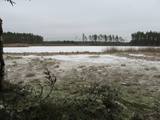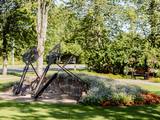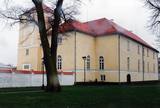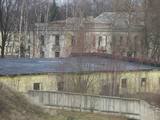| Нo | Название | Описание |
|---|---|---|
|
This is one of the most impressive and extensive natural structures of its kind in Latvia in terms of appearance and landscape. The ice age left behind this wall-like terrain, which is up to 27 metres high and at the top of which the Rīga-Ērgļi road has been built. The Great Kangari hills offer a view of the Great Kangars lake and the Great Kangari swamps and ponds. The Ķoderi castle hill, also known as the “Big Man’s Bed” is found here. The restricted area was established to protect the structure and its related biotopes and plants.
|
||
|
В саду можно осмотреть множество экзотических и редких видов растений, цветов и деревьев. |
||
|
Производители спиртовых напитков. В ассортименте продукции – водка «Саркано клиншу уденс» («Вода красных утесов»), водка и настойка из клюквы, брусники, черники, рябины, облепихи и др. Делают особый «Зиемассветку балзамс» («Рождественский бальзам»). Предлагают экскурсию, интересно рассказывают о процессе приготовления напитков. |
||
|
Название улица получила от рыбного рынка, который находился в конце улицы у площади Куршей. По адресу Рыбная улица 4/6, во дворе дома № 2 на соседней улице Пелду сохранились старые здания складов, построенные из цельных бревен. На Рыбной улице находится одна из самых популярных достопримечательностей города - Аллея славы Латвийских музыкантов (с 2006 года), на которой размещены 35 слепков рук Латвиийских музыкантов, вылитых из бронзы; выставлены 10 мемориальных досок, посвященных самым популярным музыкальным группам Латвии, а пять – уже ушедшим из жизни музыкантам. Там же находится самая большая гитара Латвии. |
||
|
The Baltic Coastal Hiking Route starts at the center of Mazirbe village where you can see the Livonian National House. Continuing through small forest and country roads past the former Mazirbe Naval school, it winds through small coastal Livonian villages: Košrags, Pitrags and then Saunags. The Livonian coast is the only place where you can get to know the cultural history heritage of one of the smallest peoples in the world, the Livonians. In this section, the indicating signs are in both the Latvian and Livonian language. At the end of route you will see Cape Kolka, the point where the Great Wave Sea meets the Little Wave Sea. It is one of the most popular bird-watching sites on the Baltic seacoast. |
||
|
The restricted area was set up to protect Nesaule Hill, which is a forested hillock in the area and features boreal and damp forests.
|
||
|
Хозяйство расположено в красивой местности, а приветливые хозяева готовят и предлагают гостям вкусную еду. Здесь также можно переночевать и посетить сауну. Хозяйство занимается как выращиванием сельскохозяйственных продуктов, так и их дальнейшей обработкой. |
||
|
Parkā blakus pusloka tiltiņam ir novietotas trīs milzīgas dzelzs atslēgas, kuras balsta akmens mūris un metāla arkas. Tās simbolizē trīs vēsturiskos centrus un to vienotību – Siguldu, Turaidu, Krimuldu. Dobēs pie šī objekta sezonāli zied dažādi kultūraugi. |
||
|
Interesantās formas no laukakmeņiem veidotā kapela celta 19. gs. Apskatāma no ārpuses. |
||
|
Pili cēla kā militāri stratēģisku objektu, tādēļ tā savā pastāvēšanas laikā ir piedzīvojusi dažādus laikus un varas. Celtne (pirmoreiz pieminēta 13. gs. beigās), neskatoties uz postošajiem kariem, ar minimālām izmaiņām ir saglabājusi savu ordeņa pils pamatapjomu un būtību, kas ir Latvijai unikāls gadījums! Dēvēta arī par Latvijas vecāko viduslaiku cietoksni. Kopš 2001. gada ēkā ir izveidots Ventspils muzejs – viens no modernākajiem Latvijā. |
||
|
The Baltic Sea littoral on the West coast of Kurzeme is called the Great Wave Sea. The seacoast is mainly sandy. While the Great Wave Sea section is the least populated coastal area in Latvia, at the same time, the third biggest city in Latvia, Liepāja, is also located there. Steep bluffs rise before your eyes on the seacoast between Pāvilosta and Sārnate. The villages are quiet and sparsely populated. At the beginning of the route, you can see the Soviet military heritage in Liepāja Karosta Prison, taste smoked local fish in Pāvilosta and then enjoy one of the most beautiful views of the entire route to the seacoast from Užava lighthouse. The route closes in the port city of Ventspils, where there are various entertainment and sightseeing places, especially for families with children. |
||
|
Dievnams vairākas reizes bija dedzis un uzcelts no jauna. Mūsdienās redzamo uzbūvēja 1874. g. un pēc 1927. g. ugunsgrēka atjaunoja 1932. gadā. Baznīcā apskatāma altārglezna „Kristus ar svēto vakarēdienu” un divas I. Zeberiņa gleznas „Jēzus pie krusta” un „Jēzus svētī bērnus” (1957. g.). Ērģeļu prospekts ir pirmais Latvijā, kas veidots „latviskā” gaumē (kokgriezējs P. Plankuss, 1936. g.), bet pats instruments ir nominēts kā Liepājas meistara Jēkaba Jauģieša skaistākais un apjomīgākais darbs. Ērģeļu stabules ir gatavotas no koka, kas nav bieži sastopams gadījums. Baznīca apskatāma no iekšpuses. |
||
|
Muzejs Egļavā stāsta par mežsaimniecību Latvijā pirmskara un pēckara periodā. Eksponēti ir ne tikai mežsaimniecības darbarīki un piederumi, bet gan apskatāmi ir arī bijušā Balvu rajona teritorijā tapušie tekstīliji, keramikas un kokamatniecības paraugi. Bijušajā mežniecības mājā pieejamas guļamistabas viesu izmitināšanai. |
||
|
Tagadējā Daugavgrīvas cietokšņa vietā pirmo nocietinājumu 1608.gadā poļu-zviedru kara laikā uzbūvēja zviedru armija. 17.gs. četrdesmitajos gados zviedru armija šeit uzbūvēja modernu cietoksni ar pieciem bastioniem un diviem vārtiem. Te bija izvietoti 120 lielgabali un mortīras, zaldātu kazarmas, virsnieku dzīvokļi, garnizona baznīca, pārtikas un munīcijas noliktavas. Ziemeļu kara rezultātā 1710.gadā cietoksnis nonāca Krievijas armijas rokās. Arī pēc Latvijas okupācijas 1940.gadā šeit izvietojās PSRS Jūras Kara flotes vienības. Diemžēl, bet unikālais vēstures piemineklis, kas atrodas valsts galvaspilsētā šobrīd publiski nav pieejams. Ļoti aptuvenu priekstatu par to var gūt, apskatot no ārpuses, kur redzami mūri, bastioni, cietokšņa grāvis un neliela daļa no vecās baznīcas. Blakus cietoksnim atrodas bijušā PSRS armijas daļa ar pamestām ēkām un pieminekli karavīriem, kas dienējuši zemūdenēs. Cietoksnis publiskai apskatei pieejams sestdienās, svētdienās no plkst. 10.00 līdz 16.00. |
||
|
Ilziņš jeb Vestienas dzirnavezers pazīstams ar nostāstiem par tajā "periodiski uzpeldošām kūdras salām". Saskaņā ar vietējo iedzīvotāju sniegtajām ziņām, minētā parādība gan sen jau vairs nav novērota. Tajā pat laikā ezers un tā apkārtne ir nozīmīga daudzu aizsargājamu biotopu un sugu dzīves vieta. Ezers ietilpst Vestienas aizsargājamo ainavu apvidū. Ezeru var redzēt, braucot pa Ērgļu - Gaiziņkalna ceļu. Var pakāpties arī blakus esošajā paugurā (ziemeļos no minētā ceļa un ezera), no kura paveras plašāka skatu perspektīva.
|
||
|
Atrodas Valmieras vēsturiskajā centrā uz bijušajiem viduslaiku nocietinājumiem. Piedāvā latvisku un lauku virtuvi. Sadarbojas ar vietējiem zemniekiem un lauku labumu ražotājiem. Plašs ēdienu klāsts visām dienas maltītēm. Vasarās – āra terase ar skaistu skatu uz Dzirnavu ezeru. |
||
|
Kuldīgu pelnīti uzskata par skaistāko Latvijas viduslaiku mazpilsētu. Tās vietā jau pirms 13. gs. atradies senās kuršu zemes Bandavas centrs. 1242. g. Livonijas ordenis pie Ventas rumbas uzsāk mūra pils celtniecību. Pie pils izveidojas apdzīvota vieta, kas pirmā (1378. g.) Kurzemē iegūst pilsētas tiesības. Nozīmīga ir arī tās dalība Hanzas savienībā. Laikā no 1561. - 1795. g. Kuldīga ir Kurzemes hercogistes galvaspilsēta. Likumsakarīgi, 17. gs. pirmajā pusē tā piedzīvo strauju saimniecisko izaugsmi, kas beidzas līdz ar Ziemeļu kara un mēra epidēmijas sākumu. Kurzemnieku lepnums un lielāku industriālu objektu trūkums ir iemesls, kādēļ padomju laikā pilsētā neieplūda lielākas imigrantu masas, tādēļ Kuldīga šodien ir viena no latviskākajām Kurzemes pilsētām. Uz Kuldīgu ir vērts braukt un uzkavēties vairāk nekā vienu dienu, jo te darāmā netrūkst. Dabas mīļotāji var vērot lidojošās zivis, bet kultūrvēstures pētniekiem te paveras visnotaļ plašs darba lauks. |
||
|
Tūrisma gide Ineta Jansone piedāvā ekskursijas grupām gar Kaņiera ezeru, iepazīstinot ar putniem, kuri mīt tā tuvumā. Kaņiera ezers ir vieta, kur migrācijas laikā apmetas daudzi tūkstoši ūdensputnu. Ezerā un tā apkārtnē sastopamas vairāk nekā 200 putnu sugu. Putnu vērotāju ērtībām vienā no Kaņiera ezera pussalām uzcelts putnu vērošanas tornis. Netālu no putnu vērošanas torņa izveidota koka laipa uz pontoniem, kura stiepjas cauri niedrāju audzei. Kaņiera ezers izceļas ar lielu daudzums zivju – tajā konstatētas gandrīz 20 zivju sugu. Izsens zvejnieku ciems - Lapmežciems atrodas skaistā vietā uz šauras zemes strēles starp Kaņiera ezeru un Rīgas jūras līci. Lapmežciemā izveidots zvejnieku muzejs, kuru var apmeklēt ekskursijas laikā, kā arī nobaudīt svaigi kūpinātas zivis. |
||
|
This tour includes a walk along the Baltic Sea coast Lithuania through the Curonian Spit from Nida to Smiltynė (see a detailed description under tour No. 9) and continues further north from Klaipėda to Šventoji located at the Lithuanian/Latvian border. Klaipėda and Palanga are popular seaside resorts with lots of pubs, hotels, street cafés and musicians. Klaipėda is the only port city and the third largest city in Lithuania. Šventoji is also a popular seaside town located next to the mouth of the river Šventoji. Between Klaipėda and Palanga, the Baltic Coastal Hiking Route leads through the Seaside Regional Park (Lithuanian: Pajūrio regioninis parkas). It was founded for the protection of coastal and marine landscapes, biodiversity and local cultural heritage. The most famous place of the seaside is the Dutch Hat (also called Dutch Cap, Dutchman’s Cap or Holland’s Cap) – a 20 m high cliff, which used to serve as a landmark and guide for seafarers and fishermen. |
||
|
Ramocku stacija atklāta 1889. gadā reizē ar dzelzceļa Pleskava-Rīga atklāšanu. 1916.gadā pēc jauna dzelzceļa izbūves līdz Gulbenei, šīs stacijas nozīme ievērojami pieauga. 1918.gadā tā kļuva par divu dažādu sliežu platumu dzelzceļa iecirkņu saskares staciju. Intensīva vilcienu kustība caur šo staciju tika izvērsta Brīvības cīņu laikā. Sadursmes pie Ieriķu stacijas notika jau 1918.gada decembrī. 1919.gadā jūnijā te sākās Cēsu kaujas. Starp Cēsīm un Ieriķiem vācieši uzbruka igauņu bruņuvilcienam. Par dažādiem nopelniem Brīvības cīņu laikā Ieriķu apkaimē, vairāki karavīri saņēma apbalvojumus, arī Lācplēša kara ordeņus.1919. gadā stacija nodēvēta par Ieriķiem. Otrā pasaules kara laikā te atradās lokomotīvju depo.1953.gadā depo vietā izveidoja stratēģiskās rezerves tvaika lokomotīvju bāzi. Pēdējā tvaika lokomotīve L-3599 Ieriķu bāzi pameta 2002.gadā un tagad ir redzama kinopilsētā Cinevilla.Ieriķu stacija vairākkārt pārbūvēta.Otrā pasaules kara laikā nodedzināta pavisam. 1956.gadā uzbūvē pašreizējo ēku. |
||



























